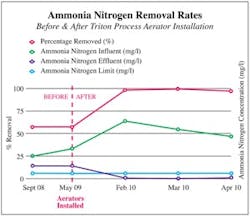A New System for Nitrogen Removal
Many small communities across the U.S. and around the globe are struggling to meet more stringent nitrification of ammonia requirements on a tighter budget. When a South African community could not meet its state requirements and struggled with a failing rotor disc system, the town’s officials found an energy saving, affordable solution that met their unique needs and met all their new permit regulations.
The town of Op Die Berg is located in the Witzenberg Municipality, nestled in the Koue Bokkeveld mountain range that lies southeast of Citrusdal in the Western Cape Province of South Africa. The region is mountainous, with beautiful isolated peaks that average 6,000 ft high, but also has broad, fertile valleys that are home to some of the country's finest vineyards.
The town’s wastewater treatment facility consists of hand-rake screen pretreatment followed by an oxidation ditch for aeration and denitrification. The wastewater is then pumped up to a dortman tank which operates as a clarifier. Sludge is sent to drying beds and effluent to a nearby river.
The seasonal influent wastewater flow varies throughout the year from an average of 0.053 million gal per day (mgd) to a maximum of 0.132 mgd. A 20-hp disc aerator was used in the oxidation ditch but was not providing sufficient aeration. A second 20-hp disc aerator was out of operation. Bearings had failed once again and the gearbox needed replacement.
“The plant was not meeting the state’s requirements of ammonia removal through nitrification,” said Nathan Jacobs, town engineer for the Witzenberg Municipality. “Also, no denitrification was taking place for the removal of nitrate.”
Process Aerator System
To replace the disc aerator, the town’s engineers chose Aire-O2 Triton process aerators and mixers manufactured by Aeration Industries Intl. , located in Chaska, Minn. In May 2009, the two 5-hp process aerators and mixers were easily installed on walkways on the Op Die Berg oxidation ditch system within a few days.
Almost immediately, the town was meeting its regulations. Although ammonia nitrogen influent levels have increased over the years, the ammonia nitrogen effluent is negligible, with removal rates at nearly 99% (see graph). Influent ammonia nitrogen levels average 54.8 mg/L, while the average effluent equals less than 0.15 mg/L. The effluent limit for ammonia nitrogen is 6 mg/L.
Since the process aerator provides both mixing and aeration in one unit and is installed directly in a basin, there are substantial savings in both equipment supply and installation costs. Compared to the brush rotor aeration systems, maintenance is minimal, which results in less costly maintenance and operational costs and thus, lower cost of ownership over time.
Jacobs said that the main reason for choosing the Triton process aerator was the system’s “superior mixing in an oxidation ditch and also the aerator’s ability to denitrify in a single basin with about 40% to 90% nitrate removal.” In South Africa, it is common for facilities to just turn off their aerators to achieve denitrification, Jacobs said. The climate of Op die Berg does not allow for this option due to extremely cold winter conditions in the Koue Bokkeveld Mountains.
Energy Savings Payback
Op Die Berg staff feel that their new aeration system fits their unique needs and, as a bonus, saves energy. The site is using a third of the horsepower of the old system and is exceeding permit standards.
“The electrical savings are significant,” Jacobs said. Previously, they had tried to save power by shutting off a horizontal disc aerator, but the results were unreliable discharge quality of the effluent. Now, he said, “the units are a third the size of the horsepower and the effluent quality is way below government requirements.”
Based on this success, Jacobs is planning to replace other horizontal disc rotors with Aire-O2 Triton process aerators in other plants that he oversees and in a few pond systems. The energy and maintenance savings are a long-term sustainable solution this community can take to the bank.
